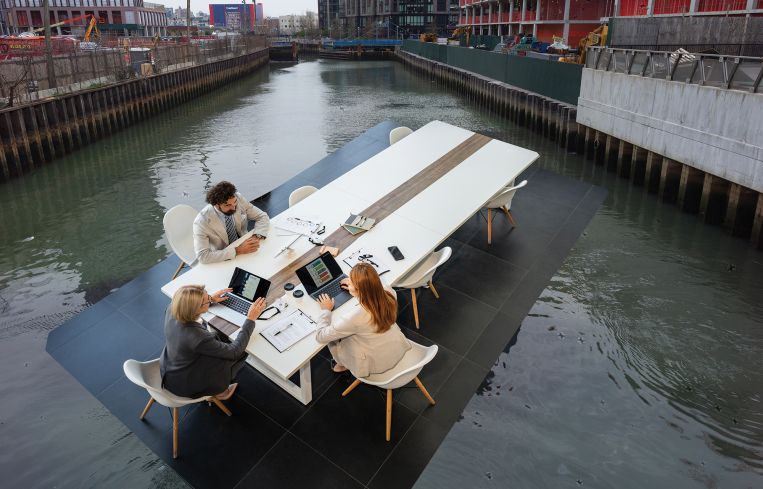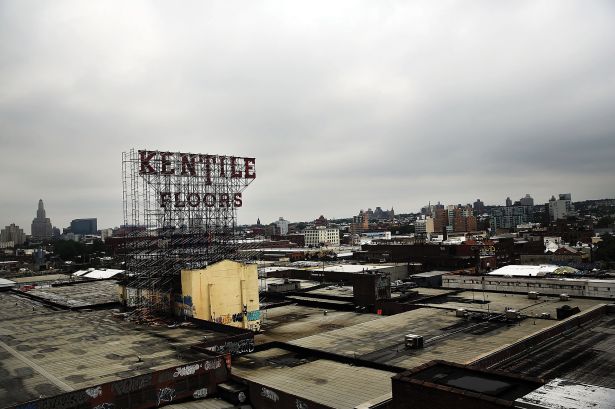Coworking Spots Continue to Proliferate Farther From Central Business Districts
Look no further than Gowanus, Brooklyn
By David M. Levitt October 21, 2025 7:00 am
reprints
The KENTILE FLOORS sign once ruled over this part of Brooklyn.
Meanwhile, the Gowanus neighborhood below was best known for the foul smell emanating from the canal that gave the area its name. On the hottest of days, the canal, an EPA Superfund site since 2010, still emits a sulphurous odor. The area otherwise is one of the hot neighborhoods of Brooklyn, attracting the younger brothers and sisters of the millennials who made nearby Williamsburg an international sensation.
It even has its own flexible offices, including those filling the same 400,000-square-foot onetime two-story warehouse at 117 Ninth Street that once bore the KENTILE sign.
Now 7 years old — in other words, predating the pandemic — the coworking facility was a harbinger of an evolution happening all across the country: coworking, or flexible offices, breaking out of the downtown central business districts and following the trend toward revived residential neighborhoods in places once ruled by warehouses and tractor trailers.
In a report last month, for instance, London-based coworking provider Hubble, a subsidiary of Yardi Systems, reported that the number of coworking locations in New York City’s outer boroughs had grown by 8 percent from 2024 to 2025, rising to 121 distinct locations.
Whereas coworking or flexible offices could once be found mainly in central business districts like Midtown Manhattan, now they’re spreading out and keeping workers off the highways and mass transit.
Charlie Bastier, Hubble senior leader, said the trend has a decidedly “mom and pop” flavor to it. The trend tends to be led by individual one-off companies rather than large ones like WeWork, IWG and Industrious that have developed worldwide reputations providing space for the short-term, small company and individual practitioner market, as well as servicing big employers who want to provide their workforce with flexible and close-to-home options.
Other outer borough flex options include the Hunters Point Studios in Queens and New Work Project in Brooklyn’s Williamsburg, Bastier said.
“These are alternatives to the coffee shop,” Bastier told Commercial Observer.
This is something that is happening all over, with coworking and flex office companies looking for growth outside the usual business hubs and instead in residential neighborhoods and suburbia.
“We need to be where people want to be,” said Peri Demestihas, head of real estate for North America for Industrious, the fourth-largest coworking company with more than 250 locations around the U.S. “There is an avid amount of demand for that that isn’t driving into Newark or driving into Manhattan. They want places that are close to them, they want places that are convenient, they want places that are amenitized, they want places that have that yoga studio, close to their day care, and have a good restaurant nearby.”
In January, CBRE bought Industrious in a deal that valued the company at $800 million, a vote of confidence that flexible offices were here to stay despite concerns about a dead cat bounce from the pandemic and advancing computer technology. CBRE had been investing in Industrious since 2020, according to a statement from the firm.
Demestihas declined to get specific with Commercial Observer about locations Industrious has opened. He did say a “vast majority” of coworking offices are popping up in markets outside central business districts.
An October report from consultancy The Instant Group found 74 percent of companies worldwide have adopted some sort of hybrid or flex work model. The top three strategies driving change in this market are a shift to hybrid work, demand for flexibility and cost reduction, the report said.
“Smaller growth markets, such as popular commuter towns or suburban areas, present greater investment opportunities, often achieving flex rates up to five times higher than traditional leasing rates,” the report stated.
“The market for suburban flexible office is more prevalent than before,” Peter Greenspan, WeWork’s global head of real estate, said via email. “Many are looking for workspaces closer to residential areas, either for part of the work week or the whole week. These locations help shorten commutes, foster the balance employees desire, and offer a community-oriented atmosphere. I believe this market is poised for continued growth.”
WeWork members have expressed “increasing interest” in locations outside CBDs, Greenspan stated. In addition to seven locations inside San Francisco, the company has opened offices in San Mateo and Mill Valley. In greater Miami, WeWork has two locations in Coral Gables, a suburban area outside of Miami. In Southern California, it has four locations in more suburban Orange County, out of the 19 WeWork locations in the Los Angeles area.
But just because something is flex doesn’t necessarily mean it’s focused on corporate tenants. The 117 Ninth Street version of this in Gowanus is geared toward artists, of which there are many in that Brooklyn neighborhood. It has turnkey private spaces where artists can splash paint and otherwise make a mess without disturbing their fellow artists, though spaces are also leased to architects, film editors, marketing companies, hair salons, nail salons and others.
Leo Gindi, who manages what is known as Gowanus Creative Studios and also manages the property for its owner — known alternatively as Regal Acquisitions and C&F Second Avenue LLC — said the building is open 24 hours, seven days a week, so there is always someone coming or going. For some, this is the space used for a second gig.
According to a recent report by brokerage giant Cushman & Wakefield, “occupiers offering flexibility are seeking locations closer to where their workforce lives,” with an expansion seen in secondary markets “that have seen rapid residential growth.” The report — which included business districts and suburban coworking locations — cited the Miami market in particular, where flexible offices lead the nation with 7.6 percent of total office inventory as of the second quarter of this year.

Fellow Sun Belt markets like greater Atlanta (3 percent) and greater Nashville (4.1 percent) are at the forefront of the trend too. Both exceeded Manhattan, which came in at just under 3 percent. Brooklyn was 6.1 percent, down from 7.9 percent, but still second in the nation behind Miami, according to C&W’s report.
“Providers follow workers and occupiers,” said Sandy Romero, manager for global research at C&W and an author of the report. “Global employers, regional employers are looking to have locations for their staff closer to where they live.”
Or, as Gindi put it, “One of our first selling points was we are 20 minutes from Manhattan. Nobody cares anymore.”
The Gowanus location is “sandwiched between Carroll Gardens and Park Slope,” he said. “Our mantra is ‘Follow the residents.’”
Locations like Gowanus track with what’s going on with flex office space in a lot of the outer-borough neighborhoods. That activity, in turn, tracks with larger shifts.
“The city is experiencing a kind of overall gentrification the last six years,” said Columbia historian Kenneth Jackson.
Gowanus itself was rezoned in 2021 to allow for denser housing development.
That post-COVID gentrification could create more demand for coworking spots farther from the city center. In fact, by 2030, Brooklyn should surpass Chicago in population, despite being much smaller in area, Jackson said. That means that if Brooklyn were its own city, it would be the third most populous in the U.S., behind New York and Los Angeles. Its population was measured at 2.65 million this year by the World Population Review.
According to the Department of City Planning, Gowanus’ population in 2010 was 104,709. In 2020 it was 113,933. Per the city’s Housing Database, Brooklyn Community Board 6, of which Gowanus is a part, added 5,246 new units between 2010 and 2014. There are plans for 133 units at 544 Carroll Street and another 360 units at 420 Carroll Street. According to data cited by Brick Underground, there are 141 residential projects in the neighborhood as of August, which could bring some 20,000 new residents to it by 2035.
The Cohen family owns 117 Ninth Street. A family member who declined to be named — because, as the person put it, the family “likes” to be discreet — said they bought the building to be a warehouse for their textile business. About half the building still serves as a warehouse, the person said. About 90,000 square feet is for the studios, cut up into what Gindi said is about 230 units. He said the building has been full or close to full for the past three years. The studios get three or four calls a month from people interested in renting one of their units, he said.
According to property records, the building was acquired by C&F Second Avenue LLC in 2004. The site does not list a sales price. “When COVID hit, people lost interest in talking to one another,” Gindi said. “People weren’t interested in hanging out in the hallway, or forgot how to. They wanted their private space.”
Owners were ready to capitalize on that shift.
“We always evolve and adapt,” said the Cohen family member. “When you own and operate the real estate, you start to get a feel of the neighborhood, and how you can serve the neighborhood. It’s not fair for [our customers] to pay premium prices in New York City.”
CORRECTIONS: This article has been updated to reflect the correct number of WeWork locations in San Francisco — it’s seven, not nine — and the correct number of Industrious locations in the U.S. It’s 250, not 145.


